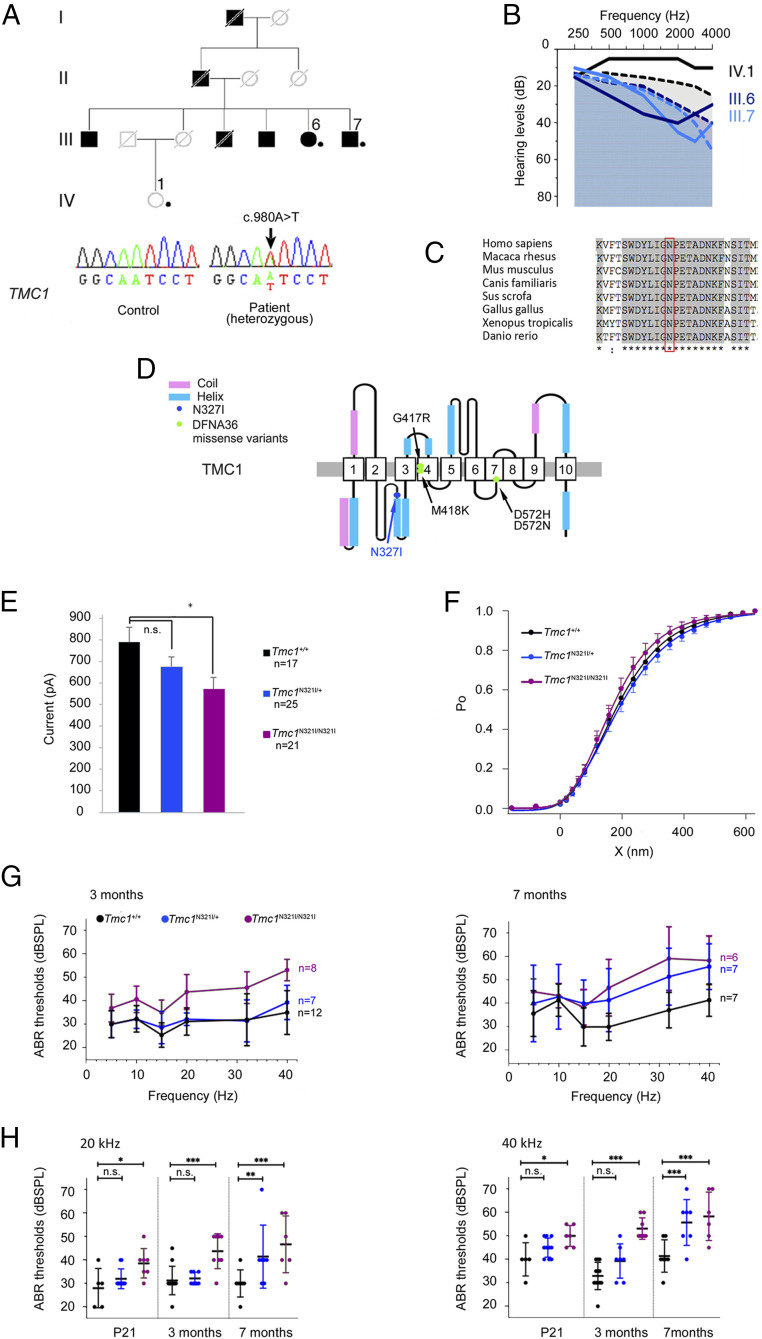Fig. 3.
Functional validation of the Tmc1N321I mutation as responsible for ARHL. (A) Pedigree of the PAR093 family (dots indicate individuals included in the genetic analysis) and DNA sequencing chromatograms of unaffected (Lower Left) and affected (Lower Right) individuals showing the variant in the heterozygous state in the ARHL patient (arrow). Nucleotide positions are based on the NM_138691.2 transcript used as a reference. (B) Audiograms of PAR093 family members: individuals with ARHL (III.6 and III.7: 63 and 59 y old, respectively) and an individual with normal hearing (IV.1: 51 y old). Dashed lines show the hearing threshold defining severe ARHL in age- and sex-matched members of the general population (in black for 51-y-old women, in dark blue for 63-y-old women, and in light blue for 59-y-old men) (SI Appendix, Patients and Methods). (C) Interspecies conservation of the asparagine residue in position 327 (boxed in red) through evolution. (D) Schematic diagram of the predicted human TMC1 protein with 10 TM domains (1 to 10), according to Pan et al. (59). (E–H) Results from Tmc1 mutant mice (in blue, Tmc1N321I/+; in purple, Tmc1N321I/N321I; in black, Tmc1+/+). (E) MET current amplitude of OHCs from Tmc1+/+ (n = 17), Tmc1N321I/+ (n = 25), and Tmc1N321I/N321I (n = 21) mice recorded on P8. The amplitude (mean ± SD) of the MET current in response to stimulation is significantly lower in cells from Tmc1N321I/N321I mice than in cells from Tmc1+/+mice. (F) MET current as a function of hair bundle displacement for Tmc1+/+, Tmc1N321I/+, and Tmc1N321I/N321I mice. For sensitivity measurements, the mean value (± SD) of the three-state derivative of the Boltzmann equation was calculated for displacements corresponding to Po values between 0.2 and 0.8. The Po(X) curves were superimposed, indicating that MET sensitivity to hair bundle displacement is unaffected in Tmc1N321I/+ and Tmc1N321I/N321I mutants. (G) Pure tone-evoked ABR thresholds (mean ± SD) in Tmc1+/+, Tmc1N321I/+, and Tmc1N321I/N321I mice at 3 (Left) and 7 mo (Right). (H) ABR thresholds (mean ± SD) at 20 kHz (Left) and 40 kHz (Right) in mice aged P21 (Tmc1+/+, n = 5; Tmc1N321I/+, n = 10; Tmc1N321I/N321I, n = 7), 3 mo (Tmc1+/+, n = 12; Tmc1N321I/+, n = 7; Tmc1N321I/N321I, n = 8), and 7 mo (Tmc1+/+, n = 7; Tmc1N321I/+, n = 7; Tmc1N321I/N321I, n = 6). n.s., nonsignificant; dBSPL, décibel sound pressure level. *P < 0.05; **P < 0.005; ***P < 0.0005.

